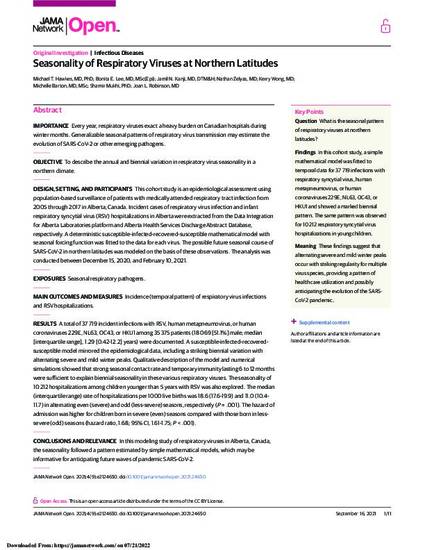
Article
Seasonality of Respiratory Viruses at Northern Latitudes
JAMA Network Open
(2021)
Abstract
Importance Every year, respiratory viruses exact a heavy burden on Canadian hospitals during winter months. Generalizable seasonal patterns of respiratory virus transmission may estimate the evolution of SARS-CoV-2 or other emerging pathogens.
Objective To describe the annual and biennial variation in respiratory virus seasonality in a northern climate.
Design, Setting, and Participants This cohort study is an epidemiological assessment using population-based surveillance of patients with medically attended respiratory tract infection from 2005 through 2017 in Alberta, Canada. Incident cases of respiratory virus infection and infant respiratory syncytial virus (RSV) hospitalizations in Alberta were extracted from the Data Integration for Alberta Laboratories platform and Alberta Health Services Discharge Abstract Database, respectively. A deterministic susceptible-infected-recovered-susceptible mathematical model with seasonal forcing function was fitted to the data for each virus. The possible future seasonal course of SARS-CoV-2 in northern latitudes was modeled on the basis of these observations. The analysis was conducted between December 15, 2020, and February 10, 2021.
Exposures Seasonal respiratory pathogens.
Main Outcomes and Measures Incidence (temporal pattern) of respiratory virus infections and RSV hospitalizations.
Results A total of 37 719 incident infections with RSV, human metapneumovirus, or human coronaviruses 229E, NL63, OC43, or HKU1 among 35 375 patients (18 069 [51.1%] male; median [interquartile range], 1.29 [0.42-12.2] years) were documented. A susceptible-infected-recovered-susceptible model mirrored the epidemiological data, including a striking biennial variation with alternating severe and mild winter peaks. Qualitative description of the model and numerical simulations showed that strong seasonal contact rate and temporary immunity lasting 6 to 12 months were sufficient to explain biennial seasonality in these various respiratory viruses. The seasonality of 10 212 hospitalizations among children younger than 5 years with RSV was also explored. The median (interquartile range) rate of hospitalizations per 1000 live births was 18.6 (17.6-19.9) and 11.0 (10.4-11.7) in alternating even (severe) and odd (less-severe) seasons, respectively (P = .001). The hazard of admission was higher for children born in severe (even) seasons compared with those born in less-severe (odd) seasons (hazard ratio, 1.68; 95% CI, 1.61-1.75; P < .001).
Conclusions and Relevance In this modeling study of respiratory viruses in Alberta, Canada, the seasonality followed a pattern estimated by simple mathematical models, which may be informative for anticipating future waves of pandemic SARS-CoV-2.
Keywords
- respiratory viruses,
- seasonality; lattitude
Disciplines
Publication Date
Fall September 1, 2021
DOI
10.1001/jamanetworkopen.2021.24650.
Publisher Statement
NA
Citation Information
Hawkes MT, Lee BE, Kanji JN, et al. Seasonality of Respiratory Viruses at Northern Latitudes. JAMA Netw Open. 2021;4(9):e2124650. doi:10.1001/jamanetworkopen.2021.24650
